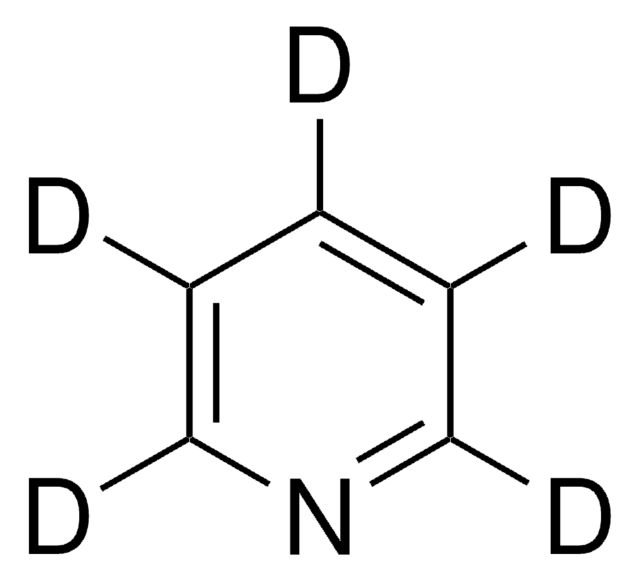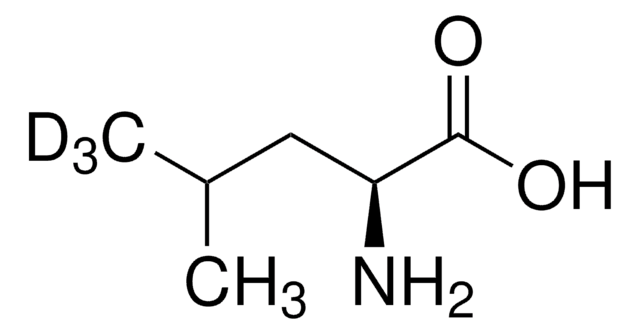488917
DL-Alanine-2,3,3,3-d4
98 atom % D
Sinónimos:
(±)-2-Aminopropionic acid-2,3,3,3-D4, Deuterated DL-alanine
Iniciar sesiónpara Ver la Fijación de precios por contrato y de la organización
About This Item
Fórmula lineal:
CD3CD(NH2)CO2H
Número de CAS:
Peso molecular:
93.12
MDL number:
UNSPSC Code:
12352209
PubChem Substance ID:
NACRES:
NA.12
Productos recomendados
isotopic purity
98 atom % D
assay
99% (CP)
form
solid
mp
289 °C (dec.) (lit.)
mass shift
M+4
SMILES string
[2H]C([2H])([2H])C([2H])(N)C(O)=O
InChI
1S/C3H7NO2/c1-2(4)3(5)6/h2H,4H2,1H3,(H,5,6)/i1D3,2D
InChI key
QNAYBMKLOCPYGJ-MZCSYVLQSA-N
Packaging
This product may be available from bulk stock and can be packaged on demand. For information on pricing, availability and packaging, please contact Stable Isotopes Customer Service.
Storage Class
11 - Combustible Solids
wgk_germany
WGK 1
flash_point_f
Not applicable
flash_point_c
Not applicable
Elija entre una de las versiones más recientes:
¿Ya tiene este producto?
Encuentre la documentación para los productos que ha comprado recientemente en la Biblioteca de documentos.
Ren Kimura et al.
Scientific reports, 10(1), 804-804 (2020-01-23)
The incidence of dementia, a clinical symptom characterized by severe cognitive decline, is increasing worldwide. Predictive biomarkers are therefore required for early identification and management. D-amino acids in the brain contribute to cognitive function and are suggested as useful biomarkers
Renyu Zhang et al.
Food chemistry, 347, 128999-128999 (2021-01-20)
The effect of in-bag dry- and wet-ageing on metabolite profiles of lamb legs was determined using Rapid Evaporative Ionisation Mass Spectrometry (REIMS). Using orthogonal projection to latent structures-discriminant analysis (OPLS-DA) with REIMS, 1705 metabolite ions were identified (Q2 = 0.86) in four
M S Brook et al.
American journal of physiology. Endocrinology and metabolism, 313(6), E681-E689 (2017-08-16)
Current methods to quantify in vivo RNA dynamics are limited. Here, we developed a novel stable isotope (D
Yutaka Konya et al.
Journal of bioscience and bioengineering, 123(1), 126-133 (2016-09-21)
Recently, the demand for d-amino acid profiling has been drastically increasing because the significance of d-amino acid in various biological events is suggested. However, the present methodologies for d-amino acid profiling are still unsatisfactory. Therefore, a highly sensitive, robust, high-throughput
Moyu Taniguchi et al.
Journal of bioscience and bioengineering, 130(1), 63-70 (2020-04-09)
Japanese sake production involves three processes: rice koji fermentation, seed mash fermentation, and main mash fermentation. Traditional seed mash (kimoto) production utilizes natural lactic acid produced by lactic acid bacteria for pure cultures of only sake yeast, preventing the growth
Nuestro equipo de científicos tiene experiencia en todas las áreas de investigación: Ciencias de la vida, Ciencia de los materiales, Síntesis química, Cromatografía, Analítica y muchas otras.
Póngase en contacto con el Servicio técnico





